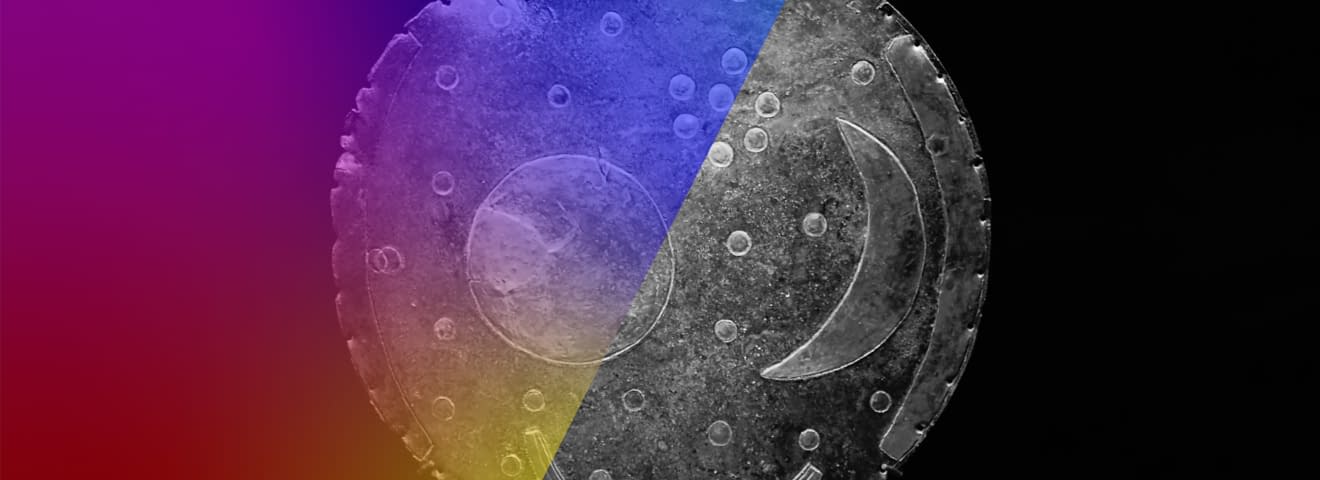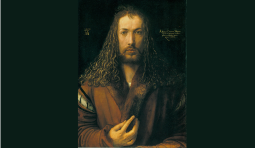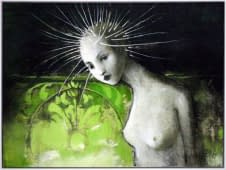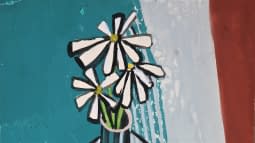The Rainbow #1 - The first rainbow representations
The Refracted Colour in the Firmament
The colour spectacle in the firmament can be observed worldwide under the right conditions and has impressed people around the globe from the very beginning. As a result, the rainbow has influenced a wide variety of cultures, religions and superstitions, as well as the arts, music and literature. How the colour arc was perceived at the beginning of our humanity and what effect it had still remains a mystery to us to a certain extent, just like the rainbow itself. After all, despite the scientific knowledge that explains its creation to us, the phenomenon still retains something magical. Goethe expressed this tension between science and fascination of this natural wonder in a touching way in Faust II:
Let the sun shine on, behind me, then!
The waterfall that splits the cliffs’ broad edge,
I gaze at with a growing pleasure, when
A thousand torrents plunge from ledge to ledge,
And still a thousand more pour down that stair,
Spraying the bright foam skywards from their beds.
And in lone splendour, through the tumult there,
The rainbow’s arch of colour, bending brightly,
Is clearly marked, and then dissolved in air,
Around it the cool showers, falling lightly.
There the efforts of mankind they mirror.
Reflect on it, you’ll understand precisely:
We live our life amongst refracted colour.
The Rainbow in Different Regions of the World
But what was before this scientific knowledge? What do we know about the significance of the mystical rainbow in prehistory and early history? Cultural evidence gives us clues and information about it, especially written sources. The rainbow shaped many cultures. So, let's look back at how humankind explained the colourful refraction at the beginning.
Among the Mayans, for example, the mother goddess Ix Chel is not only the goddess of the earth and moon and the patroness of water, she is also the goddess of the rainbow, which is her tiara. For the Incas, the rainbow is the deity K'uychi. However, the Incas were also afraid to look at the rainbow as it was seen as an evil omen. They believed that rainbows were celestial serpents, which were associated with danger. The snakes can continue to move on earth even after they have disappeared in the sky. The majority of them are said to be evil, stealing men or entering women's wombs through the vagina and causing pain. However, the rainbow goddess is also considered a symbol of procreation and gives the earth its colours.
In ancient Egypt, too, the bow was associated with a celestial serpent and associated with death and the underworld. The serpent god Mehen (ancient Egyptian "to curl up", "to wrap around") accompanies the sun god Re every night into the underworld and protects him there so that he can rise again in the east. Mehen was often depicted in hieroglyphs with a double bow. He shows the sun its path through his bow. For meteorological reasons, the arch cannot be depicted near the sun. So, there are hardly any direct references to rainbow depictions, but it is assumed that rainstorms occurred in ancient Egypt from time to time and rainbows were thus sighted.
Rainstorms also occurred regularly in the geographical north. Accordingly, in Sami shamanism, Thiermes or Horagalles is the god of the sky, thunder, lightning, weather, oceans and lakes, as well as the rainbow. The rainbow is his bow with which he shoots his arrows. Thus, the rainbow is also used as a weapon. In Norse mythology, the phenomenon represents a three-beam rainbow bridge connecting Asgard and Midgard, the realms of the gods respectively of the humans. This bridge is called Bifröst, which means "swaying skyway".
There were also various interpretations in the Asian region. In China, the rainbow was used to mend a crack in the sky with five coloured stones cast by the snake-legged goddess of creation, Nüwa. In Hinduism, there are various deities associated with the rainbow. For example, it is the bow of Rama, an incarnation of Vishnu. The Indian deity Indra, god of the sky, storm and rain, used the rainbow to kill the serpent Vritra with lightning. Maya, goddess of creation, is symbolised by the seven colours of the rainbow, which are intangible. Thus, she creates an illusion of the world. Accordingly, her name from Sanskrit means "illusion, sorcery" or literally "the great non-being". For Buddhists, the rainbow symbolises the highest state one can reach before nirvana or enlightenment.
The Aborigines in Australia also believe that the rainbow is a snake that inhabits the sky. This represents the creative as well as the destructive power of nature in connection with water and rain. Because floods were already occurring on the coasts of Australia at that time. The two-sex rainbow serpent also represents the infinity of the world and the dreamtime, an important part of Aboriginal culture and mythology. Depictions of these rainbow snakes can also be found in rock paintings, for example in Arnhem Land (Mount Borradaile), which is probably between 6,000 and 9,000 years old.
The Babylonian Gilgamesh epic, which was written around 2000 BC and influenced later Akkadian and Sumerian literary works, also spoke of this phenomenon. In the Gilgamesh epic, the rainbow stands for the divine sanction for war, but also for immortality. Thus, in Mesopotamian writings, Gilgamesh seeks eternal life from his ancestor Utnapishtim, who survived a flood on an ark. Ishtar, goddess of lust and war, appears to him. In the story, she wears a necklace that is interpreted as a rainbow. The narrative is taken up in the Old Testament with the tale of Noah. In Genesis, a destructive yet merciful God offers the rainbow as a promise of peace. The rainbow thus served as a link between God and humanity. In the New Testament, the interpretation of the coloured ring was expanded, but more on that in the next blog.
In Greek mythology, the name of the goddess Iris is linked to the rainbow itself, her name literally means "rainbow". But "eiris" also means "messenger", so the name has a double meaning. In Greco-Roman cosmogony, the arch of colours is a path drawn by the winged messenger Iris to connect heaven and earth. Although she is closely related in genealogy to Gaia, the Mother Earth, she had a minor role as a goddess. In the 5th century BC, however, she was considered important enough that separate sculptures were made of her on a pediment and a metope in the Parthenon in Athens. The surviving torso is now in the British Museum. Iris was primarily regarded as a mouthpiece for other deities. Her messages were rarely about peace and happiness, but mostly about war and death or simply advice. On behalf of Zeus, she often took on an acting role in the intrigues of Greek stories. But Iris is also a goddess of the sea and the sky. For the Greeks living on the coast, the rainbow was mostly seen over the sea, which is why it was assumed that the goddess filled up the rain clouds with water from the sea. Her role changed constantly during antiquity. Thus, the rainbow was later no longer her personification, but her temporary symbol, her trace, appearing whenever it pleased her. The name "iris" continues to be found in our linguistic usage today in reference to the colours of the rainbow. For example, as a flower or for the coloured aperture of our eye. But the word also describes the optical experience of iridescence, for example in pearls or soap bubbles. So, there is a linguistic connection between colours and vision.
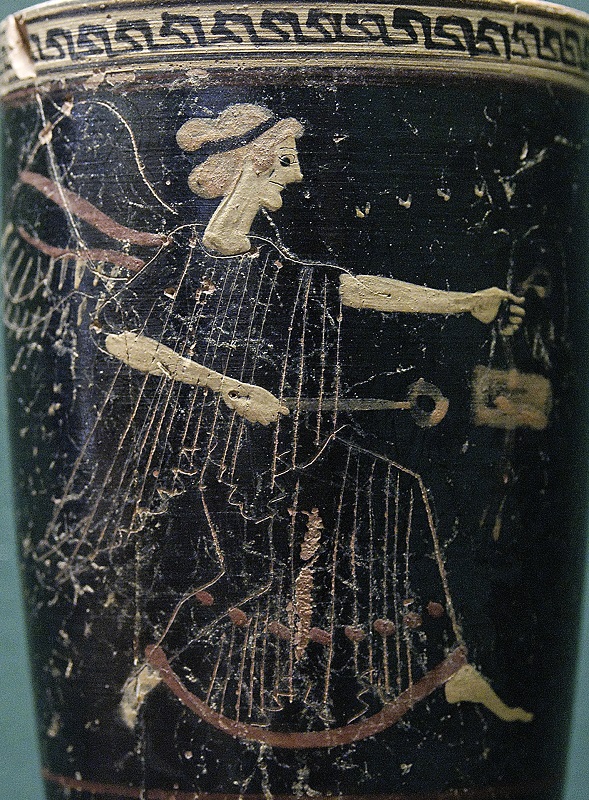
First Pictorial Evidence of the Rainbow
But what did the first representations of the rainbow look like, when they did not appear in the form of a snake, like those in Australia? One of the oldest images interpreted as a rainbow is a pictogram in the Tassili n'Ajjer mountains in the Sahara of Algeria, which is probably 5,500 years old. In this mountain chain, today a desert with wadis and sandstone monoliths, a Mediterranean climate prevailed in the Neolithic, i.e., conditions favourable for cattle breeding and civilisation, as rock paintings confirm. The image shows a horned, running woman painted with white stippling. She is interpreted as a dancer or goddess. Between her legs is another female figure framed by a round arch; possibly a rainbow.
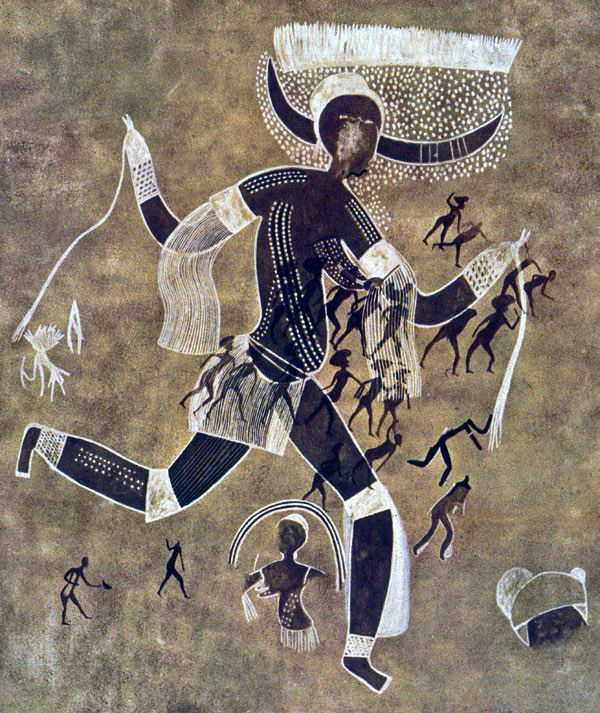
The white spotting of the dancer can be read as ornamental scars, however, such spots also represented divine rain in the Near East and in Greece. The dots above the horned head could thus be drops of water falling from the white cloud onto her body. The wavy lines emerging from her arms and hip are reminiscent of rain bundles known from Mesopotamian scroll seals. The people of the Neolithic therefore clearly invested spiritual and artistic energy in the depiction of the promising sky arch.
The rainbow was also important in later cultures. The one by Tassili n'Ajjer even bears striking resemblance to ancient depictions in the western USA. Although the geographical distance rules out a connection, this suggests that there were commonalities in visual perception, generating similar artistic output. These similar petroglyphs and rock paintings were found in Utah, among other places, in the so-called San Rafael Swell. In the beginning, the nomadic people of this region left behind drawings of a predominantly abstract nature. Later, simple representative elements emerged, possibly as a result of settlement or to bear witness to external contacts. It is believed that the descendants of the Colorado Plateau, the Hopi and the Navajo, continued to use the rainbow symbol in their religious art, for example in the form of ceremonial robes or in sand painting. The rainbows on the rocks usually appear together with anthropomorphic figures who seem to idolise the rainbow by their clothing and pose. Often clouds, lightning or rain showers are also depicted. These meteorological symbols are probably linked to ceremonial practices. This also expresses a concern for maintaining sufficient rainfall in the predominantly dry region.
The rainbow image was thus an important symbol for the nutrition and prehistoric agricultural cultures of the people, where existence was tied to the summer rainfall and the rainbows associated with it. The stone certainly limited the way the rainbow could be depicted, especially in relation to realism.
The artist's imitation of nature therefore opens up many questions, some of which can also be transferred to the cultures mentioned at the beginning: Are the broken colour sequences correctly represented in multi-coloured pictograms? Are double rainbows also depicted? Or even several? How did the people of that time see colours and did they already have words for the colours? And how did language influence colour perception?
For the Utah petroglyphs, it is believed that realistic representation was not so important in a ceremonial depiction, as only the abbreviated symbolic content was to be transmitted. The rainbow is usually depicted in a ceremonial setting in remote, arid locations, often in juxtaposition with floating, anthropomorphic figures that seem to transcend normal humans, as well as plants, animals, masks, rain ships and cloud patterns. This suggests a simultaneous practice of ancestor worship. The early rock art style is believed to be the work of a group of artist-shamans in pre-agrarian times and probably originated before the 1st century AD. Further developments show the rainbow alternating in white and red colours. Probably the earliest correct representation of a rainbow is an image found in San Rafael Fremont (ca. 700-1200 AD). In Arizona, another alternating rainbow is found, together with a figure playing a flute. The flute was later used in Hopi rituals as a rain-making instrument.
Although the representations were used in ceremonies, all this, also in connection with representations of planets, supernovas and the solstice, points to a rational observation that was in this way associated with faith. The meteorological phenomenon was therefore part of a cultural understanding that had magical and mystical qualities. For the shamans, the rainbow was a bridge through which they could travel to heaven in an ecstatic state. Thus, the rainbow is a bridge between the physical and spiritual worlds.


Neolithic representations have also been found in Europe. In Spain, in the cave "Los Letreros", the so-called Indalo figure was discovered. The figure holds a bow in its two hands, which is interpreted as a rainbow and possibly represents wisdom and truth and should protect mankind from evil spirits and bad things. Other theories, however, simply see a hunter with a bow.
One of the most well-known objects in Europe that could possibly depict a rainbow is the Nebra Sky Disk. Its dating is controversial, as it was found by looters at the time. The majority dates the disc between 2,200-1,550 BC, but one opinion suspects that it was made much later, around 500 BC. According to the latter, the arch on the disc is a rainbow. This would generally fit into the Iron Age, when Celtic swords were also discovered showing crescent moons, suns and rainbows, thus also having a protective function. The exact meaning of the rainbow for the people of this time and region is not known. Other interpretations see the disc as a sundial or as astronomical information linked to a specific place.
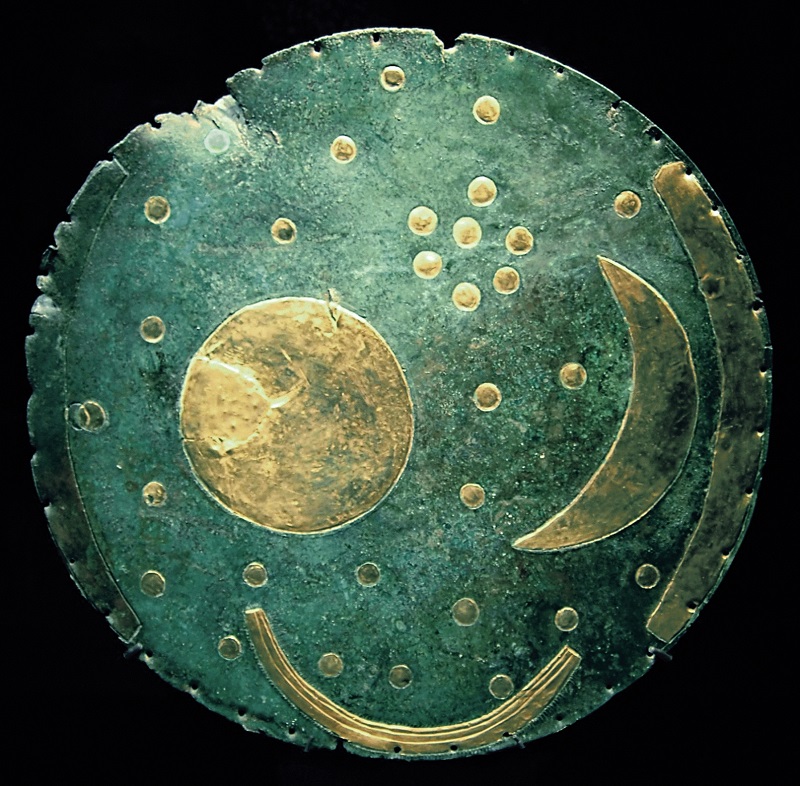
The rainbow thus had a mediating function between the heavenly and the earthly in many cultural areas. It was often a positive symbol, especially as it brought rain and thus fertility. But very often in the form of a dangerous serpent, the rainbow also meant danger and was sometimes associated with destruction, weapons (bows) and war. Simultaneously, however, the shining rainbow could also be a sign of peace and reconciliation as well as a symbol of protection. The optical phenomenon was thus caught between the cult of fertility and the destructive rage, between hope and suffering.
The colours of the rainbow were and are as diverse as the ideas of the cultures, which are unfortunately impossible to discuss in detail here. Apart from astonishing parallels, there are also many differences. Although prehistoric depictions of this interplay of colours are still rare and limited in their expressiveness, it is possible that new objects will be discovered in the future or that already known but still unexplored or enigmatic objects will be recognised as rainbow depictions. In the next blog, you will find out how the representation and the meaning developed in the Middle Ages.
Glossary:
Petroglyph: A rock image chiselled or pecked into stone from prehistoric times, often also elaborated with paint. In contrast, pictographs are rock paintings made only with paint.
Hopi: Native Americans of northeastern Arizona.
Navajo: Native Americans of northern New Mexico and Arizona.
Anthropomorphic: Figures with human form, human-like features and characteristics. Animals, gods and forces of nature thus take on human forms.
Photo Credit:
Fig. 1: Lekythos made of clay with Iris as a messenger on the belly of the vessel, painter from Diosphos, Athens around 500-490 B.C., on display at the Louvre, Paris, photo: Marie-Lan Nguyen (CC BY 3.0).
Fig. 2: Reproduction of the original, running horned woman, rock painting, 6'000-4'000 BC. B.C., Tassili n'Ajjer, Algeria. Photo: smarthistory.org.
Fig. 3: Series of small (10 cm), possibly double-rowed, rainbow pictograms executed in red paint over figures resembling flying birds. The otherworldly anthropomorphs surrounded by snakes and small birds are in classic Barrier Canyon style. The plaque is located on top of a bluff in the Head of Sinbad region in the center of Utah's San Rafael Swell. Photo: Bob Sihler.
Fig. 4: Petroglyph of an alternating white and red rainbow with anthropomorphic figures and abstract symbols, Ferron Box in San Rafael Fremont, Utah. Photo: gjhikes.com: Ferron Box
Fig. 5: The Nebra Sky Disc, bronze and gold, State Office for the Preservation of Monuments and Archaeology, Saxony-Anhalt, on display in the State Museum for Prehistory in Halle. Photo: Dbachmann, (CC BY-SA 3.0).
